Some unfinished business today: the finals of the 2013 Venice cup. The hands have been on my desk for a while and I finally got around to analyzing them in detail. Why is this set interesting?
With two sessions to go, the English team had a comfortable lead: 46 ahead. With 32 boards to play, the USA2 team had to gain about an 1.5 imp/board to overtake them. That is a lot, though not impossible. However, considering the experience of the English team, some of the players were contesting the same event as early as 1984, you'd think that this resulted in an easy win. Not so, a huge set by the USA2 team (84-33) turned the match around and the USA2 eventually won the event by 8 imps.
117 imp's on 16 boards is a lot. On Facebook, it was suggested that the huge turnover was caused by the Americans using gambling tactics and being lucky, but was this really the case? Let's look at the hands. Some of the hands have been rotated for convenience and we will jump from table to the other, depending where the action is.
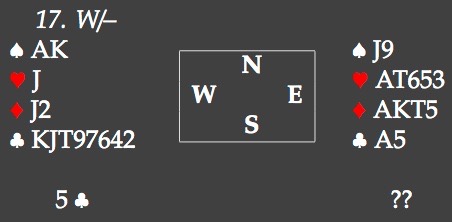 Board 17: The English west opened 5♣ and south had a hard time deciding what to do. She finally settled for
the sure plus and her partner quickly wrapped up 13 tricks. I'm not
sure about the benefits of 5♣.
If it is the opponent's hand, they won't be able to do anything but
double for about 500. If partner has a good hand, she will have to
guess right. Partner did have a good hand, bidding 7♣ is no longer possible but I think it is worth a raise. South thought otherwise. At the other table, the auction started 1♣-1♥-3♣ and south took control though NS ended in only 6♣. 7♣ was bid twice, in the Bermuda Bowl Final. Another observation: 2 pairs opened 2♣ precision style, which looks like an underbid to me, considering that
you'd also do this with 6 clubs, 2 random small red cards but the same
high cards. Anyway, 11 to the USA.
Board 17: The English west opened 5♣ and south had a hard time deciding what to do. She finally settled for
the sure plus and her partner quickly wrapped up 13 tricks. I'm not
sure about the benefits of 5♣.
If it is the opponent's hand, they won't be able to do anything but
double for about 500. If partner has a good hand, she will have to
guess right. Partner did have a good hand, bidding 7♣ is no longer possible but I think it is worth a raise. South thought otherwise. At the other table, the auction started 1♣-1♥-3♣ and south took control though NS ended in only 6♣. 7♣ was bid twice, in the Bermuda Bowl Final. Another observation: 2 pairs opened 2♣ precision style, which looks like an underbid to me, considering that
you'd also do this with 6 clubs, 2 random small red cards but the same
high cards. Anyway, 11 to the USA.
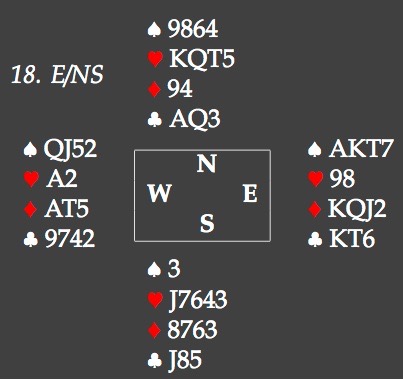 Board 18. Identical auctions at both tables: 1NT, Stayman, and 2♠ raised to 4♠.
South has a blind lead. A spade is out, as this may give away the bad
trump split too soon. With a clear club lead, partner would have
doubled 2♣, so
you are probably going to lead a red suit. There are arguments in favor
of either one but they are not very strong. In practice, one table led
a heart, the other a diamond. The US heart lead worked out better than
the UK diamond lead, as the former forced declarer to take a guess.
Unlucky, at most, definitely not a gambling action by anybody. 10 to the
USA2 team.
Board 18. Identical auctions at both tables: 1NT, Stayman, and 2♠ raised to 4♠.
South has a blind lead. A spade is out, as this may give away the bad
trump split too soon. With a clear club lead, partner would have
doubled 2♣, so
you are probably going to lead a red suit. There are arguments in favor
of either one but they are not very strong. In practice, one table led
a heart, the other a diamond. The US heart lead worked out better than
the UK diamond lead, as the former forced declarer to take a guess.
Unlucky, at most, definitely not a gambling action by anybody. 10 to the
USA2 team.
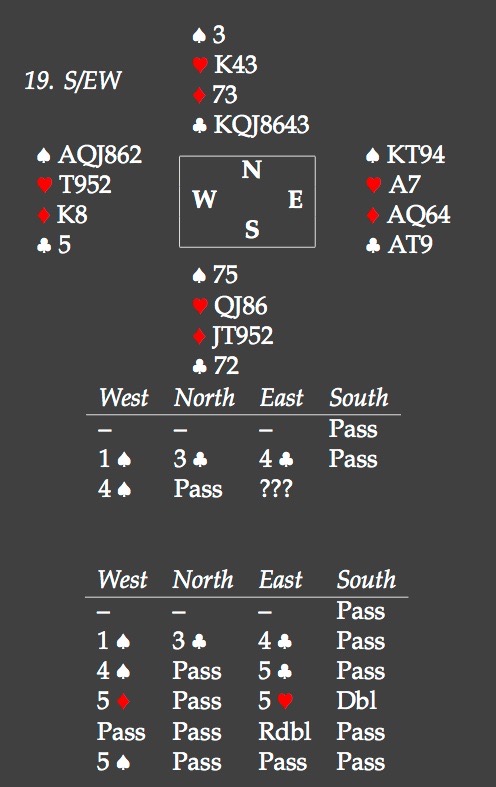 Board 19: Identical start of the auction: 1S-(3♣)-4♣ as a spade raise with a hand too strong for a direct 4S. West showed a minimum with 4♠ and it is your turn.
Board 19: Identical start of the auction: 1S-(3♣)-4♣ as a spade raise with a hand too strong for a direct 4S. West showed a minimum with 4♠ and it is your turn.
The US east simply asked for keycards and bid 6♠ when partner showed the ♠AQ. This is quite reasonable, partner figures to have a singleton club and must have some red suit values for her opening bid. The english women at the other table were too subtle here, I can understand the 5♣ bid from east, but once partner shows a diamond control and makes a forward going move over 5♥x by passing, you must bite the bullet and bid slam. 13 to the US.
Board 20 cost the English another 12, on a hand where both declarer and defence have to guess right. The English got it wrong at both tables, the USA got it right both times. For those of you keeping count, that is 46 imp's in 4 boards.
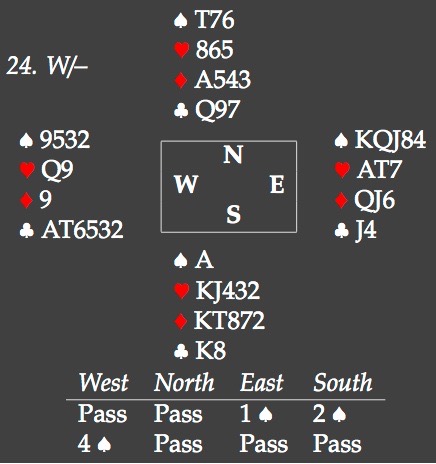 Board
24: You are on lead as south and you are not happy about that. Your
distribution is known (2S showed 5-5 in hearts and a minor), none of
your suits like to be led and you will also often find yourself on lead
again at trick 3 when you don't want that. The US solved it nicely by
leading the ♠A
and a presumably suit preference small spade from north. Next a diamond
to the ace and a heart back. That set up the 4th defensive trick for
down 1. It may appear that the diamond return sets up a trick to discard
a heart. While that is correct, declarer does not have an entry to the
hand to actually use that discard. Nicely done.
Board
24: You are on lead as south and you are not happy about that. Your
distribution is known (2S showed 5-5 in hearts and a minor), none of
your suits like to be led and you will also often find yourself on lead
again at trick 3 when you don't want that. The US solved it nicely by
leading the ♠A
and a presumably suit preference small spade from north. Next a diamond
to the ace and a heart back. That set up the 4th defensive trick for
down 1. It may appear that the diamond return sets up a trick to discard
a heart. While that is correct, declarer does not have an entry to the
hand to actually use that discard. Nicely done.
At the other table, the english south led a diamond. That would set the contract too if north switches to a heart in trick 2. She didn't, even though she could probably figure out that south didn't have the ♦KQ (she would have led the ♦K) or the ♥AK (she'd led that suit). The actual spade return gave declarer a chance that she took: spade to the ♠A, south cannot return anything, declarer now has an entry to set up the ♦Q and score enough ruffs in the process. This looks as if these are 10 self-inflicted imps.
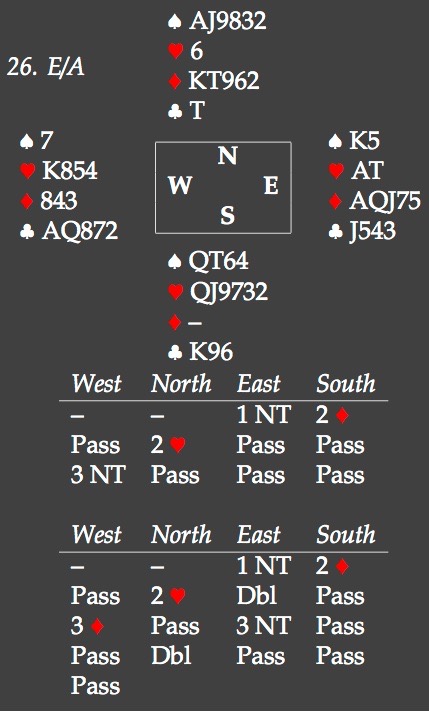 Board 26: A curious hand. EW can take 9 tricks in NT while NS are cold for 4♠.
Neither table got to bid spades though. The English north doubled 3NT
for a non heart lead, only to find out that no lead can defeat 3NT.
Another 8 to the west of the Atlantic.
Board 26: A curious hand. EW can take 9 tricks in NT while NS are cold for 4♠.
Neither table got to bid spades though. The English north doubled 3NT
for a non heart lead, only to find out that no lead can defeat 3NT.
Another 8 to the west of the Atlantic.
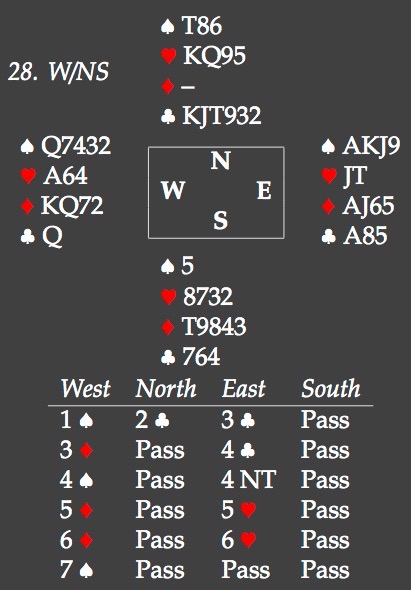 Board 28: The english bid 7♠ with only 12 tricks from top and no way to develop a 13th. I don't quite understand the 7♠ bid. It looks as if east asked for something extra in the heart suit,
west didn't have it (she has already shown the HA) but still bid the
grand. The best contract is 7♦,
that makes with most 3-2 and 4-1 diamond splits by simply ruffing 2
clubs and pitching a heart on the 5th spade. In practice, diamonds
split 5-0. The English could have considered himself unlucky if they
lost 14 with 7♦ down 1 against 6♠ making, but not with the actual result. 14 more out of the window.
Board 28: The english bid 7♠ with only 12 tricks from top and no way to develop a 13th. I don't quite understand the 7♠ bid. It looks as if east asked for something extra in the heart suit,
west didn't have it (she has already shown the HA) but still bid the
grand. The best contract is 7♦,
that makes with most 3-2 and 4-1 diamond splits by simply ruffing 2
clubs and pitching a heart on the 5th spade. In practice, diamonds
split 5-0. The English could have considered himself unlucky if they
lost 14 with 7♦ down 1 against 6♠ making, but not with the actual result. 14 more out of the window.
Did you keep count? This is -78 imp's in 7 boards, equally distributed over the two tables and none of them caused by wild or gambling tactics from the opponents. Any of the swings could have been avoided by playing better.
The final result of the match was an 8 imp difference, the lowest of any of the swings above.
